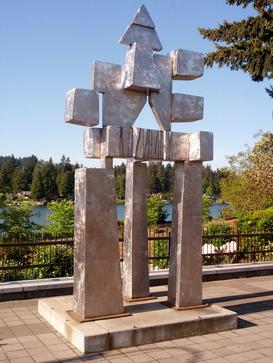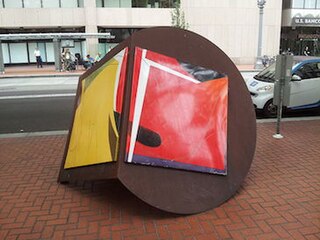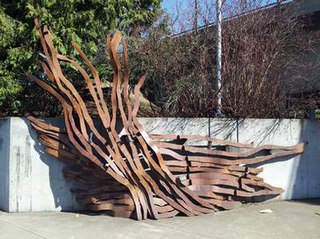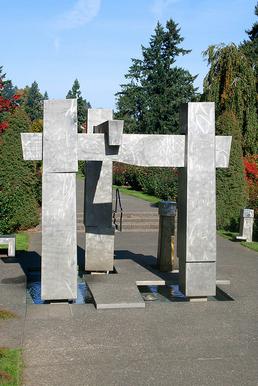
Friendship Circle is a collaborative art installation by American artist Lee Kelly and musician Michael Stirling, located in Portland, Oregon's Tom McCall Waterfront Park, in the United States. The installation features a stainless steel sculpture with two 20-foot towers, designed by Kelly, and a 35-minute score composed by Stirling. It celebrates the sister city relationship between Portland and Sapporo, Japan.

Sacajawea and Jean-Baptiste is a bronze sculpture of Sacagawea and Jean Baptiste Charbonneau by American artist Alice Cooper, located in Washington Park in Portland, Oregon, in the United States.

Angkor I is an outdoor stainless steel sculpture by Lee Kelly, located at Millennium Plaza Park in Lake Oswego, Oregon, in the United States. The 1994 sculpture stands 14 feet (4.3 m) tall and weighs 1,000 pounds (450 kg), and was influenced by his visit to Southeast Asia one year prior. In 2010, Angkor I appeared in an exhibition of Kelly's work at the Portland Art Museum. In 2011, it was installed at Millennium Plaza Park on loan from the Portland-based Elizabeth Leach Gallery. The Arts Council of Lake Oswego began soliciting donations in 2013 in an attempt to keep the sculpture as part of the city's permanent public art collection, Gallery Without Walls. The fundraising campaign was successful; donations from more than 40 patrons, including major contributions from the Ford Family Foundation and the Oregon Arts Commission, made purchase of the sculpture possible. Angkor I has been called a "recognizable icon" and a "gateway" to the park's lake.

Thompson Elk Fountain, also known as the David P. Thompson Fountain, David P. Thompson Monument, Elk Fountain, the Thompson Elk, or simply Elk, is a historic fountain and bronze sculpture by American artist Roland Hinton Perry. The fountain with its statue was donated to the city of Portland, Oregon, United States, in 1900 for display in Downtown Portland's Plaza Blocks. It is owned by the City of Portland.
Mimir is an outdoor bronze and concrete sculpture by Keith Jellum, installed in northwest Portland, Oregon, United States. The 1980 sculpture was commissioned by the Portland Development Commission and Tom Walsh of Tom Walsh Construction, and is part of the City of Portland and Multnomah County Public Art Collection courtesy of the Regional Arts & Culture Council.

Echo Gate is an outdoor 2001 sculpture by Ean Eldred and the architectural firm Rigga, located along the Eastbank Esplanade in Portland, Oregon, United States. It was funded by the City of Portland Development Commission's Percent for Art program, and is part of the City of Portland and Multnomah County Public Art Collection courtesy of the Regional Arts & Culture Council.

Talos No. 2 is an outdoor 1959–1977 bronze sculpture created by the American artist James Lee Hansen. It is located in the Transit Mall of downtown Portland, Oregon, in the United States.

Running Horses is an outdoor 1986 bronze sculpture by Tom Hardy, located on the Transit Mall in downtown Portland, Oregon. It is part of the City of Portland and Multnomah County Public Art Collection courtesy of the Regional Arts & Culture Council.

Sculpture Stage is an outdoor 1976 stainless steel sculpture by Bruce West, located in Tom McCall Waterfront Park in downtown Portland, Oregon. The work was funded by the Comprehensive Employment and Training Act and is part of the City of Portland and Multnomah County Public Art Collection courtesy of the Regional Arts & Culture Council.

Howard's Way is an outdoor 2007 art installation comprising four stainless steel sculptures by American artist Lee Kelly, located in downtown Portland, Oregon.

Untitled is an outdoor 1977 steel and porcelain enamel sculpture by American artist John Killmaster, located in downtown Portland, Oregon. It is part of the City of Portland and Multnomah County Public Art Collection courtesy of the Regional Arts & Culture Council.

118 Modules is an outdoor 1979 sculpture by American artist John Rogers, located at the parking garage at Southwest Yamhill Street between Southwest 9th and 10th Avenues in downtown Portland, Oregon.

Untitled is an outdoor 1977 painted aluminum sculpture by Ivan Morrison, located at Southwest 5th Avenue and Southwest Oak Street in the Transit Mall of Portland, Oregon.

Alluvial Wall is an outdoor 2001 sculpture by Peter Nylen and the architectural firm Rigga located along the Eastbank Esplanade in Portland, Oregon.

The Frank E. Beach Memorial Fountain, officially titled Water Sculpture, is an abstract 1975 stainless steel fountain and sculpture by artist Lee Kelly and architect James Howell, installed in Washington Park's International Rose Test Garden in Portland, Oregon. The memorial commemorates Frank E. Beach, who christened Portland the "City of Roses" and proposed the Rose Festival. It was commissioned by the Beach family and cost approximately $15,000. Previously administered by the Metropolitan Arts Commission, the work is now part of the City of Portland and Multnomah County Public Art Collection courtesy of the Regional Arts & Culture Council.

Holon, also known as Hōlon, is an outdoor stone sculpture by Donald Wilson, located in the South Park Blocks in Portland, Oregon, United States. It was originally commissioned in 1978–1979 and re-carved in 2003–2004. It is part of the City of Portland and Multnomah County Public Art Collection courtesy of the Regional Arts & Culture Council, which administers the work.

Festival Lanterns is an outdoor 2006 art installation consisting of granite and steel sculptures by American artist Brian Goldbloom, installed in northwest Portland, Oregon, in the United States. The work is administered by the Regional Arts & Culture Council.
Elkhorn is an outdoor 1979 sculpture by Lee Kelly, installed at Catlin Gabel School in West Haven-Sylvan, a census-designated place in Washington County and the Portland metropolitan area, in the U.S. state of Oregon.
Tree of Life is an outdoor 1964 sculpture by Lee Kelly and Bonnie Bronson, with additional assistance from John Jelly and architect John Murtaugh, installed on the exterior of the University of Portland's Mehling Hall, in Portland, Oregon, United States.


















